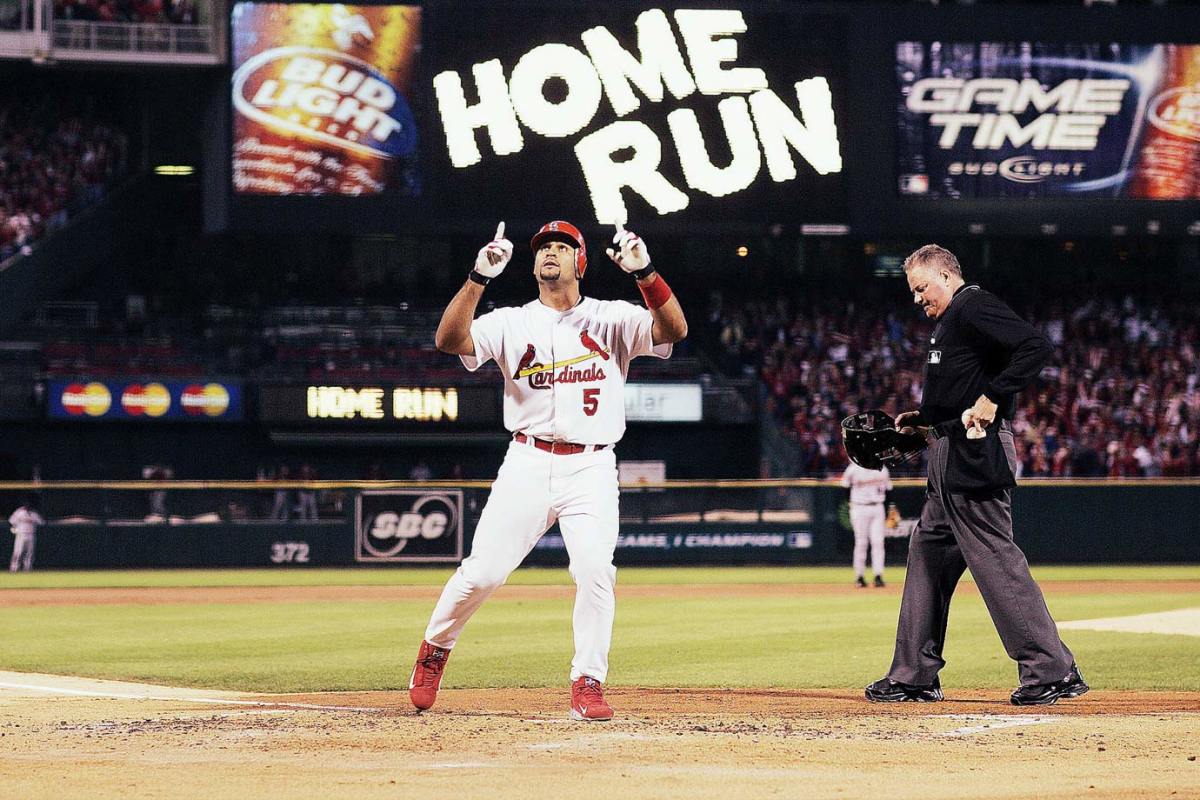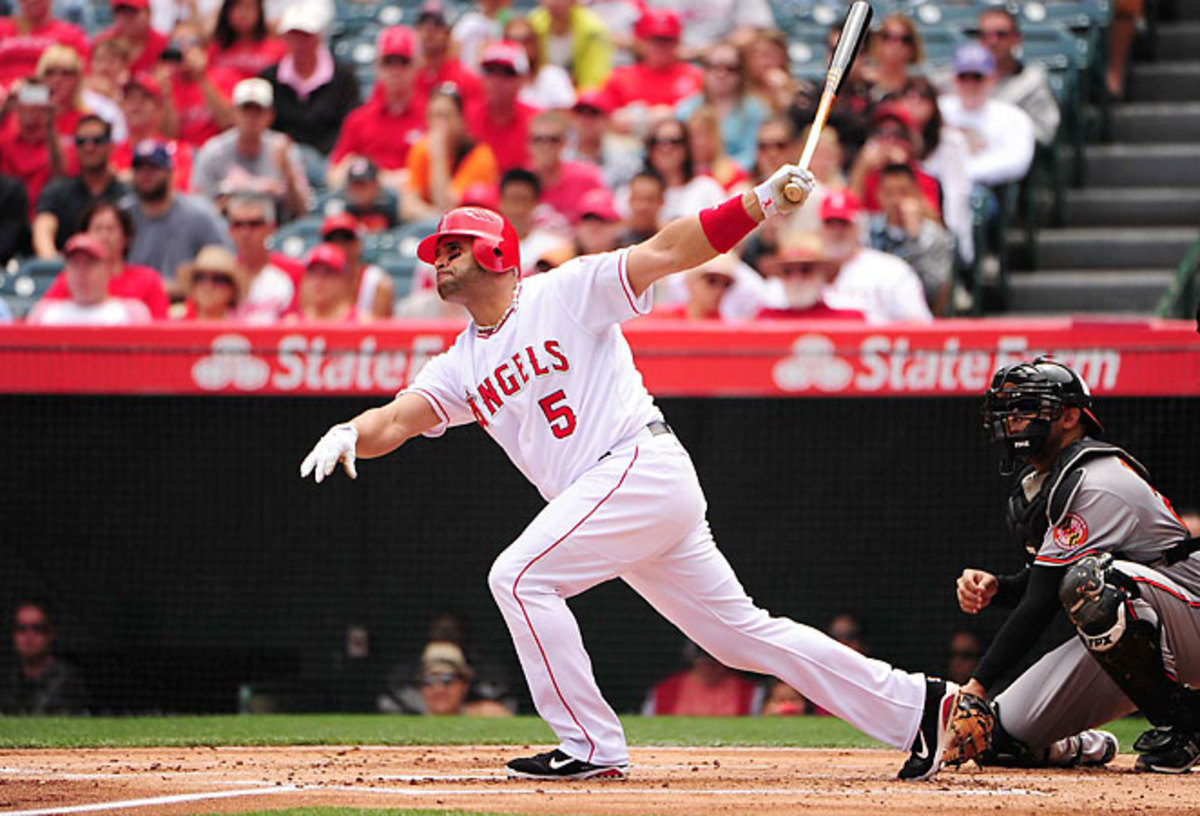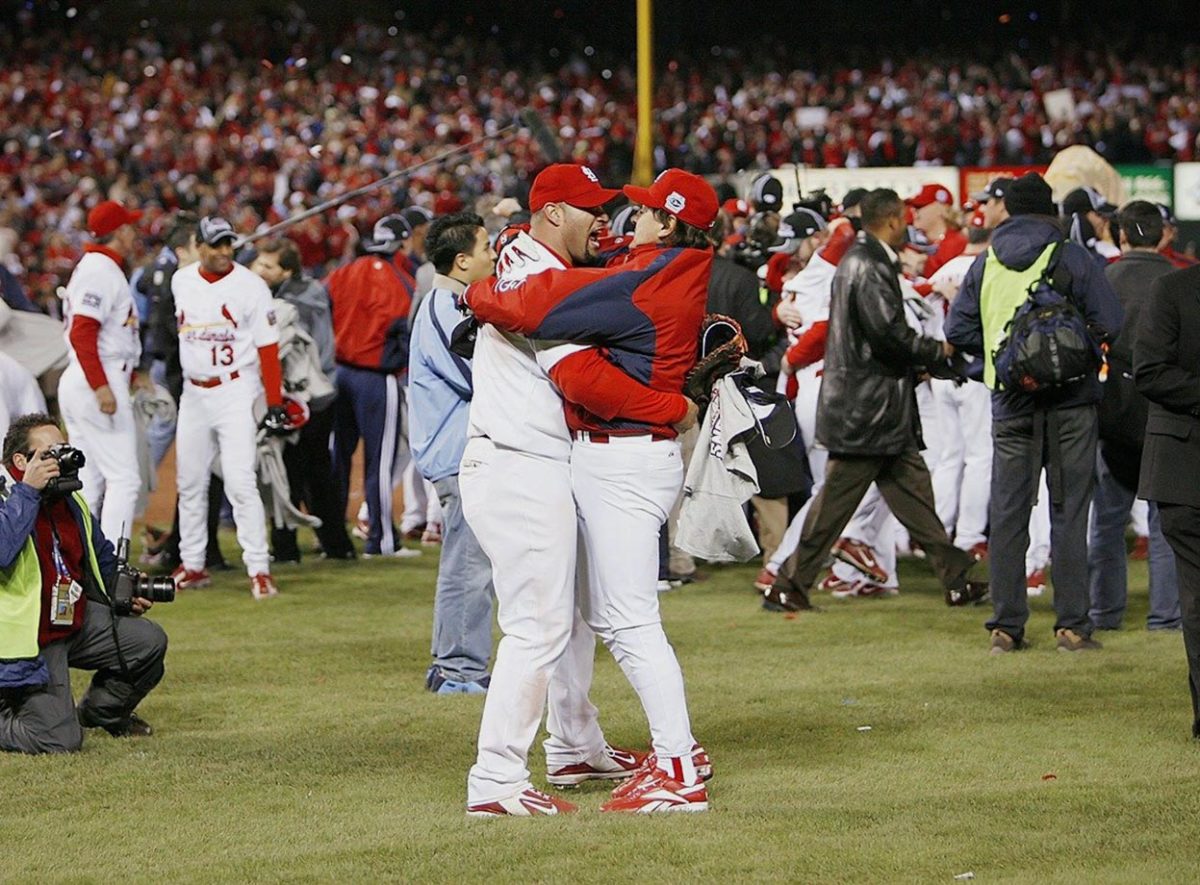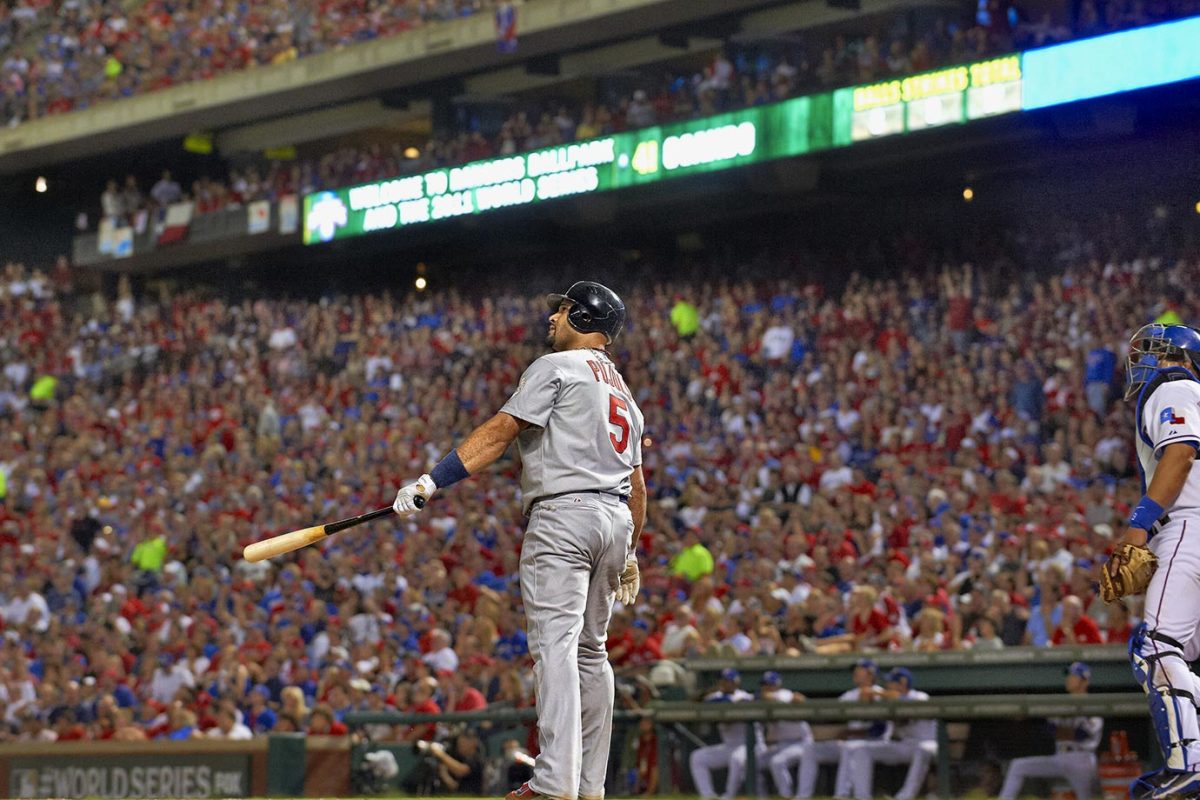The Wonder of Albert Pujols
The end of greatness is often so horrid as to invoke pathos. Ken Griffey Jr., hitting .184, drove away from the Mariners one night without a word to anyone. Mike Schmidt, hitting .203, suddenly quit on a road trip, and mentioned the one thing he would miss about Major League Baseball: room service french fries. Babe Ruth, hitting .181, feuding with the Boston Braves owner and hobbling on an achy knee, said he knew it was time to go when he played a single into a triple in left field at Baker Bowl in Philadelphia.
Albert Pujols, the greatest hitter of his generation and the best first baseman since Lou Gehrig, was designated for assignment by the Los Angeles Angels on Thursday with a .198 batting average. Pujols had been a .300 career hitter ever since his fifth game in the big leagues. It fell below .300 20 years later on the second day of last season. Hitting .218 since then, he left the Angels—and probably baseball for good—at .298.
Griffey, Schmidt, Ruth and Pujols all played their last game in May, which speaks to when the end is obvious. Such is the exhaustion of hope that even a wide swath of schedule ahead means nothing.
But here is what is important about inglorious exits: they are not important. Who contemplates the arc of Griffey’s swing, the power of Schmidt’s bat or the impact of Ruth on American culture and goes straight to how the sweetness ended? No one. So it will be with Pujols.

Today does feel sour. Pujols’ game eroded with age, heavy legs and the growth of shifts, which conspired against him just as he needed to cheat to get to a fastball. In the first 14 years of his career, Pujols hit .470 when he pulled the ball. But faced with a phalanx of defenders on the left side of the infield in the modern game, Pujols hit .335 to that side since 2015. His career .349 batting average on balls hit in play to the left side crumbed to .261 in these past seven years. Every groundball he hit to the left side, and there were many, was a sad reminder of what he once was.
Such images fade. What remains forever, carved deep into the stone of baseball history, is the hitting genius of Pujols. He did what the inner circle Hall of Famers did: he did not just post extraordinary numbers, he also changed the game.
Before the word existed Pujols was an influencer. His hitting mechanics were so efficient and his strike of the baseball was so pure and consistent that coaches and players used him as a template. But like Koufax’s curveball and Ruth’s swing, few came even close to duplicating Pujols’s results. Pujols and Hank Aaron are the only players with 600 homers, 600 doubles and 3,000 hits.
Not everybody gets to leave like Derek Jeter, who had that trademark inside-out walkoff single in his last game at Yankee Stadium in 2014. As Jeter headed to the finish line that year, I asked Pujols when he might know when he was done.
“I don’t know,” he told me. “It’s hard. I know I have several more years after this on my contract. I think the moment is going to determine it. If I stop having fun in this game, then it’s time to go. Regardless of what [the contract] is.
“I play this game, since I was growing up, because I love it. Where I come from, that’s what they do. I just enjoy every moment. I’m blessed to have this opportunity. Many, many people wish they had this opportunity.
“Sometimes you get caught in the pressure and try to do too much and you forget to have fun. I’m always having fun, talking to other guys. They even come to first base and ask me about hitting. I try help them out as much as I can in the 30 seconds before the pitcher throws the next pitch That’s me. I don’t think I will ever change that. That’s the same way I was taught growing up, having great people who took me under their wing in St. Louis.
“Placido Polanco is one of my best friends. He tells me, ‘When you lose that joy, when you stop having fun, I think it’s time to go.’”
One of the many great treats I have enjoyed is to spend time with Pujols in his batting cage while training in the offseason. As I wrote:
“To be inside the cage, with Pujols providing the lecture notes to what he does, is to be inside Room 109 of Princeton’s Fine Hall in the days of Einstein.”
It happened just after he signed that 10-year, $240 million contract with the Angels. It was fascinating to watch such a hitting genius at work. The seriousness and focus were palpable.

“See that piece of tape on the back screen?” he asked me.
There was a small piece of tape in the netting of the back of the cage about six feet off the ground.
“I want to hit it about three feet below that. I want to hit it the same height as the pitch.”
He mashed ball after ball off the tee at the exact spot three feet below the tape. This was before most anybody was talking about launch angle. Pujols wanted to hit nothing but line drives.
“Albert Pujols,” Lance Berkman told me, “is the greatest hitter of all time.”
Berkman, a teammate of his in St. Louis, said he made that distinction because of how Pujols was the best hitter in the modern game, as bullpens grew deeper with specialists and the game opened to international talent.
The amazing part of Pujols's story is where he came from: nowhere, or at least according to the baseball hype community. In a world where everybody wants to tag the next great hitter, Pujols is likely the last Hall of Famer who arrived with zero fanfare. He played largely off the baseball grid at Maple Woods Community College. A Rockies scout dismissed him as “heavy legged” with an erratic arm. The Rays tried him behind the plate and watched him fail to hit a home run in batting practice. The Cardinals took him with the 402nd pick of the 1999 draft, in the 13th round.
“When I got drafted people were saying I wasn’t good enough to make it to the big leagues,” he said in 2012. “I’m used to dealing with those negative things. So here I am 11 years later, you know?”
Two years after being drafted, at age 21, he was just another guy with a lineman’s number at the Cardinals’ spring training camp. Manager Tony La Russa kept playing him all over the diamond. Pujols kept hitting. A few days before Opening Day, the Cardinals sent Pujols to the minor league camp, preparing to officially re-assign him to the minors. Then Bobby Bonilla tore a hamstring. And so the Pujols Era began.
In his first 10 seasons, Pujols averaged 41 homers, 123 RBIs and a slash line of .331/.426/.624. It was one of the greatest runs of sustained hitting in the modern game. By comparison, Mike Trout in his first 10 seasons averaged 30 homers, 80 RBIs and a slash line of .304/.418/.582.

The wonder is not that Pujols could not sustain such elite hitting with the Angels. It is that it happened in the first place. Too much has been made of his contract with the Angels, about how it was “an albatross.” If you look at baseball only as an actuary or as a fantasy league player, and your worth of a player is reduced to a ratio of dollars paid to WAR accumulated, you are missing the human factor of the game.
Angels owner Arte Moreno knew what he was doing. He told me he wanted to sign Pujols for $25 million a year for eight years.
“In a perfect world it was going to be eight 25s,” Moreno said. “I don’t think you sign him in a perfect world.”
Moreno got what he called “the best player in baseball.” He bought prestige for his club. Moreno was carrying no debt. He had no players signed past 2015. He was drawing three million fans regularly. He knew he had a handshake deal to triple his local television contract from $50 million to $150 million per year. Signing Pujols would all but guarantee that TV deal and that the Angels would be watchable. Moreno also would be getting one of the great hitting teachers and truest of professionals, characteristics that would play well with young players in the Angels’ clubhouse.
Pujols hit home runs 500 and 600 in an Angels uniform. His mark on the franchise will continue to be made as part of a 10-year personal services contract. Moreno had wooed Pujols, fresh off the disappointment of how the Cardinals did not try harder to keep him, by assuring him the Angels “take care of their own,” by explaining how former Angels such as Bobby Grich and Rod Carew were always a part of the team’s family.
It matters not if he wears a Cardinals cap or an Angels cap on his Hall of Fame plaque. That is minutiae. His career was as big as anything we’ve seen since Aaron and Mays. The three MVPs. The jaw-dropping postseason home run off Brad Lidge in Houston. The stretch in 2011 World Series Game 3 that may be the finest display of hitting ever seen in the Fall Classic: five hits off five pitchers in a span of six innings. The last three hits were home runs. He set a World Series record with 14 total bases.

Driven. It is the best way to describe Pujols. Once he put on his uniform early each afternoon, he wore a Do Not Disturb look. It was out of focus and commitment to task, not out of some dark personality. If you approached Pujols you did so cautiously, warily. But if you knew him you knew that the fierce look would quickly melt, especially if you wanted to talk hitting.
So driven was Albert Pujols that he estimated he took 50,000 swings per year. Multiply that by 21 seasons and you get more than one million swings. On his laptop Pujols would keep videos of all of his game swings. If something did not feel quite right in his setup or swing, he could go back to one of his swings. The template of the template.
“Which model year,” I asked him, “is the go-to template?”
He first said 2009, but then thought for a second and added 2010, but then he thought some more and just laughed as he caught himself at the absurdity of picking one swing from a decade of some of the greatest swings ever seen.
“Oh-one to 2010,” he said. “Any one.”
Any swing in any year among 10 years. Imagine that. Imagine such sustained greatness. Just try to imagine if we will see the likes of that again. And let that thought swirl in your head today, not in how one of the game’s great careers came to an end.
More MLB coverage:
• Apstein: Yankees Fans Taunt Astros in First Trip to Bronx Since Scandal
• Baccellieri: Five Takeaways From Baseball's First Month
• Verducci: Baseball's Mental Health Reckoning
